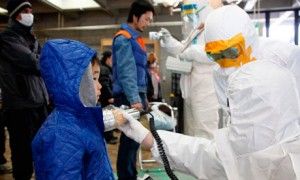Rad Reading Up In Seawater Near Plant
TOKYO — Radioactivity levels have soared in the seawater outside the troubled Fukushima Daiichi nuclear plant, safety officials reported Saturday, igniting fresh concerns about the spread of highly radioactive material and the risks involved in completing an already dangerous job.
Samples taken 360 yards offshore from the plant Friday showed radioactive iodine levels 1, 250 times the legal safety limit. Earlier in the week, the levels of iodine-131 in the water had been closer to 100 times the limit.
As of Saturday, some signs of progress were evident at the plant: Fresh water was being pumped in to cool the first three nuclear reactors, rather than seawater, which leaves salt deposits that can impair the cooling process. And the lights were turned on in the control room of the second reactor.
But Chief Cabinet Secretary Yukio Edano told reporters at a news conference Saturday that it is difficult to predict when the crisis at the plant might end. He also urged Tokyo Electric Power Co., which operates the plant, to relay information more promptly to the government and improve its transparency.
On Thursday, three workers at the plant sustained severe radiation burns on their legs; two had been wearing ankle boots instead of higher boots that would have offered more protection. Japan’s nuclear agency warned Saturday that Tepco should pay more attention to worker safety.
At the overheated nuclear plant, stricken more than two weeks ago by a 9.0-magnitude earthquake and the resulting tsunami, engineers are awaiting mass shipments of fresh water that can be used to cool the overheated reactors. Two U.S. Navy barges, each carrying 1,100 tons of fresh water, are en route to the plant, and the first of those barges should arrive Monday.
Officials feel a growing pressure to use fresh water rather than seawater for their cooling operations amid concerns that salt deposits left by seawater can corrode the reactors. Water supplied by the U.S. vessels will be pumped into a massive cooling tank at the plant.
Click here to read more.


